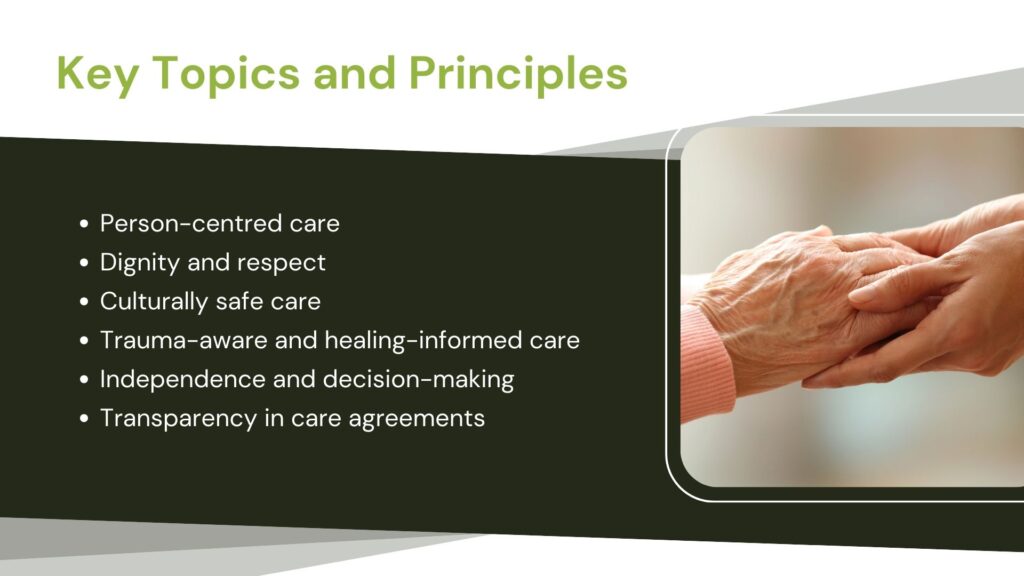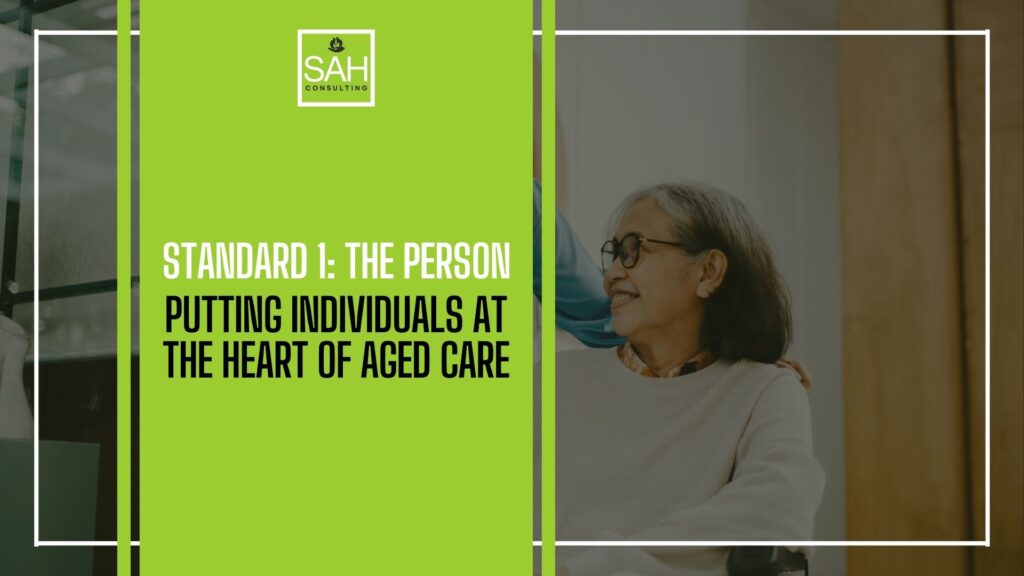From July 2025, the Strengthened Aged Care Quality Standards will come into effect under the new Aged Care Act and the Support at Home Program. These changes mark a shift towards better, more consistent care across the sector. At the centre of these reforms is Standard 1: The Person.
This standard underpins all others. It sets the tone and expectations for the full suite of aged care quality standards. When providers focus on the person first—understanding their values, preferences, and life story—every other aspect of care becomes easier to deliver well.
Get this right, and the rest follows naturally. This is not about adding complexity. It’s about returning to the core of aged care: seeing and supporting the person in front of you.
What Standard 1 Means
Standard 1 begins with the voices that matter most:
For older people: “I am valued and have a choice over the life I lead.”
For Workers: “I understand the people I care for and support them in choices that impact their lives.”
This Standard places the individual at the centre of all care and services. It calls for providers to recognise each older person’s identity, history, preferences, and rights. Care must reflect their life story—not just their current needs.
There are four outcomes and 21 actions in Standard 1. These do not introduce new topics, but they set clearer expectations. They focus on understanding the diversity of older people, including specific requirements for First Nations people and those living with dementia.
For those asking what are the 8 Standards of aged care, it’s important to note this new framework replaces them with seven strengthened standards—starting with Standard 1 as the core. Understanding this standard is key to delivering true person-centred care.
Key Topics and Principles
Providers must apply the following principles in daily care and service delivery:
- Person-centred care: Build professional, trusting relationships with each individual. Understand their history, preferences, and needs to deliver care that reflects who they are.
- Dignity and respect: Treat every person with respect. Protect their privacy, support their rights, and offer real choice in how they live.
- Culturally safe care: Recognise and respond to cultural identity. This includes providing care that is safe, appropriate, and respectful—particularly for First Nations people and those living with dementia.
- Trauma-aware and healing-informed care: Understand that past trauma may affect how care is received. Create an environment that supports healing and emotional safety.
- Independence and decision-making: Support older people to make their own choices, including the right to take risks. If they need help deciding, involve a substitute decision-maker only after trying all options to support their independence.
- Transparency in care agreements: Be open and honest about care arrangements. Make sure agreements are clearly explained and understood.
These principles are not optional. They are the foundation of safe, respectful, and effective aged care.

Required Outcomes and Actions
Standard 1 includes 4 outcomes and 21 actions. All actions align with or build on existing responsibilities. They focus on recognising each person’s needs, rights, and preferences.
Outcome 1.1: Person-centred care
Care and services are tailored to the individual’s needs, preferences, and life experiences
Actions:
- Understand and value the older person’s identity, culture, diversity, beliefs, and life experiences.
- Develop care and services in partnership with the older person, considering their needs, goals, and preferences.
- Provide culturally safe care that respects the older person’s cultural identity.
- Deliver trauma-aware and healing-informed care that acknowledges past experiences.
- Support the older person’s autonomy and decision-making.
- Foster professional and trusting relationships between staff and the older person.
Outcome 1.2: Dignity, respect, and privacy
Older people are treated with dignity and respect, free from discrimination, and their privacy is upheld.
Actions:
- Treat the older person with dignity and respect in all interactions.
- Ensure the older person receives care and services free from discrimination.
- Respect and uphold the older person’s personal privacy.
Outcome 1.3: Choice, independence, and quality of life
Older people are supported to make choices about their care and services, maintain their independence, and achieve quality of life.
Actions:
- Support the older person’s independence and ability to make decisions about their care and services.
- Provide information in a way that supports the older person’s understanding and decision-making.
- Support the older person’s right to take risks that they understand and accept.
- Use supported decision-making approaches to assist the older person in making choices.
- Identify and involve substitute decision-makers when the older person is unable to make decisions.
- Promote the older person’s quality of life by supporting their goals and preferences.
- Address communication barriers to support the older person’s participation in decision-making.
Outcome 1.4: Transparency and agreements
Care and service agreements are transparent, and the older person is informed and involved in decisions.
Actions:
- Provide clear and understandable information about care and services to the older person.
- Develop care and service agreements in partnership with the older person.
- Ensure the older person understands the terms and conditions of their care and service agreements.
- Support the older person’s autonomy by involving them in decisions about their care and services.
- Use open disclosure practices when things go wrong, informing the older person and taking appropriate actions.
Demonstrating Conformance
Providers must show how they meet Standard 1 through clear, consistent actions. These must be documented, monitored, and reviewed with input from the people receiving care.
Document Your Systems and Processes
Keep thorough records of care plans, service agreements, and risk assessments. Use clear language and show how decisions are made and updated over time. Good documentation supports audits, internal reviews, and continuous improvement. It also proves you understand and act on the person-centred approach required under the aged care quality standards.
Monitor and Observe Care Delivery
Use checklists, audit tools, and observations to ensure staff deliver care in line with policies. Regularly assess whether services reflect the older person’s preferences and rights. Case studies and examples from real situations help demonstrate that policies are applied in daily practice.
Engage with the People You Care For
Involve residents in developing and reviewing their care plans. This builds trust and ensures services reflect what matters most to them. Co-designed care promotes dignity, choice, and independence—key principles of Standard 1.
Collect and Use Feedback
Gather feedback from older people, families, staff, and your governing body. Use surveys, complaints data, and informal check-ins. Act on this input. Show how feedback leads to changes—whether through updated procedures, staff training, or new care practices. Feedback loops are critical for quality improvement and accountability.
Reflective Questions for Providers
Use these questions to pause and assess how well your service aligns with the intent of Standard 1. They’re designed to support ongoing reflection and improvement in person-centred care.
- How do you tailor care to each person’s life story and preferences?
- How do you support older people in making decisions—including those involving risk?
- What systems are in place to make sure culturally safe and trauma-aware care is provided?
- How do you act on feedback from older people and staff?
SAH Consulting: Your Partner in Navigating Support at Home Complexities
SAH Consulting supports aged care providers across Australia in navigating regulatory change. Our team brings deep expertise in the Support at Home Program and registration process.
We help providers understand and apply the new aged care standards. From reviewing documentation to preparing for audits, we offer clear, practical guidance. Preparing early makes compliance smoother and reduces pressure later. If you’re unsure where to start, reach out—we’re ready to support you.
Final Thoughts
Now is the time to act. Review your systems, engage your staff, and start embedding person-centred care in everyday practice. You don’t have to do it alone—support is available.
For a deeper understanding of what’s required, read the Aged Care Quality Standards PDF. It outlines expectations in detail and helps you plan with confidence.
Need guidance? Contact SAH Consulting—we’re here to help you move forward. Our experts can provide tailored advice and hands-on support to guide you through the registration process and beyond. The sooner you reach out, the better prepared you’ll be for the changes ahead.
